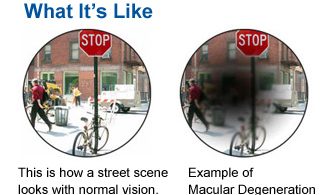Hardening Of Retinal Arteries
Macular Degeneration Treatment
01
What is Macular Degeneration?
Age-related macular degeneration (ARMD) is a degenerative condition of the macula (the central retina). It is the most common cause of vision loss in the United States in those 50 or older, and its prevalence increases with age. ARMD is caused by hardening of the arteries that nourish the retina. This deprives the sensitive retinal tissue of oxygen and nutrients that it needs to function and thrive. As a result, the central vision deteriorates.
This example demonstrates what a patient with advanced macular degeneration sees. Macular degeneration varies widely in severity. In the worst cases, it causes a complete loss of central vision, making reading or driving impossible. For others, it may only cause slight distortion. Fortunately, macular degeneration does not cause total blindness since it does not affect the peripheral vision.
ARMD is classified as either wet (neovascular) or dry (non-neovascular). About 10% of patients who suffer from macular degeneration have wet ARMD. This type occurs when new vessels form to improve the blood supply to oxygen-deprived retinal tissue. However, the new vessels are very delicate and break easily, causing bleeding and damage to surrounding tissue.Patients with wet macular degeneration develop new blood vessels under the retina. This causes hemorrhage, swelling, and scar tissue but it can be treated with laser in some cases. Dry macular degeneration, although more common, typically results in a less severe, more gradual loss of vision. The dry type is much more common and is characterized by drusen and loss of pigment in the retina. Drusen are small, yellowish deposits that form within the layers of the retina. Macular degeneration may be caused by variety of factors including genetics, age, nutrition, smoking, and sunlight exposure.
02
Signs and Symptoms
Loss of central vision; this may be gradual for those with dry ARMD. Patients with wet ARMD may experience a sudden decrease of the central vision, difficulty reading or performing tasks that require the ability to see detail, and distorted vision (straight lines such as a doorway or the edge of a window may appear wavy or bent.)

03
Detection and Diagnosis
Eye physicians usually diagnose ARMD.
Vision testing, Amsler grid test, ophthalmoscopy, fundus photography and fluorescein angiography are some common tests performed during a retinal exam.
Treatment
There is no proven medical therapy for dry macular degeneration. In select cases of wet macular degeneration, laser photocoagulation is effective for sealing leaking or bleeding vessels. Unfortunately, laser photocoagulation usually does not restore lost vision, but it may prevent further loss. Recently, photodynamic therapy has proven to be effective in stopping abnormal blood vessel growth in some patients with wet AMD. This new type of laser treatment is far less damaging than laser photocoagulation and is the treatment of choice in many cases. Early diagnosis is critical for successful treatment of wet macular degeneration. Patients can help the doctor detect early changes by monitoring vision at home with an Amsler grid.
